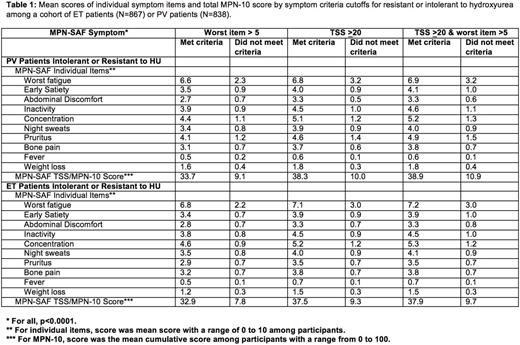Abstract
BACKGROUND:
Symptom burden in essential thrombocythemia (ET) and polycythemia vera (PV) is severe even among individuals with low risk disease (Blood 2012. 12;123(24):3803-10). New therapies exist which alleviate the severe symptom burden and reduce splenomegaly in ET and PV patients (N Engl J Med 2015; 372:426-435). This analysis is the first to date to evaluate thresholds at which symptom-based treatment can be considered for ET and PV patients who are intolerant or resistant to hydroxyurea (HU).
METHODS:
Patient demographics, symptom burden, and disease traits were collected from ET and PV patients at a single time point during therapy. The MPN-10 total symptom score (TSS, JCO 2012;30(33)4098-103) was utilized to assess symptom burden. Symptom criteria models were determined as previously described among a population of MF patients (Scherber et. al. EHA 2016: a2250). Cutoffs were then evaluated in a cohort of ET and PV patients to assess for utility as a symptom model among this population.
RESULTS:
Demographics and symptom burden: 838 PV and 867 ET patients with previous hydroxyurea therapy were included in this analysis. Patients were of mean age (54.9 years ET, 64.0 years PV) and gender (69.2% female ET, 55.7% female). Mean disease duration was 6.0 years for ET and 7.3 years for PV.Among ET and PV patients, 15.0% and 24.2% had prior thrombosis respectively. In evaluating prognostic risk, ET patients tended to be low (45.5%) or intermediate risk (42.9%) with only a minority of patient meeting criteria forhigh risk disease (11.6%).
Laboratory findings: ET patients had a mean platelet value of 598.7x 109/L(SD=283.4). Among PV patients, mean hematocrit was 45.8% (SD=8.1) and 42.6% of patients had a hematocrit of greater than 45%. White blood cell count was normal between the two groups (ET mean 8.3 x 109/L, PV mean 9.0 x 109/L).
Symptoms: Mean worst symptom severity was 6.4 out of 10 (SD=2.7). Among ET patients, worst symptom was most frequently fatigue (32.7%, mean 5.0/10, SD=3.1, overall prevalence 88%) followed by night sweats (13.6%, mean 2.0/10, SD=3.0, overall prevalence 53%) and concentration difficulties (8.6%, mean 3.1/10, SD=3.0, overall prevalence 68%). For PV, worst individual symptom items were most frequently fatigue (29.2%, mean 5.2/10, SD=3.0, overall prevalence 91%), pruritus (14.1%, mean 3.2/10, SD=3.2, overall prevalence 69%), and night sweats (12.8%, mean 2.5/10, SD=3.0, overall prevalence 57%).
Cutoff Scoring: 47.0% of ET patients fit criteria for TSSgreater than to equal to 20; 59.0%% had a single itemgreater than 5; and 45.7% had both a TSS greater than or equal to 20 and a single item greater than 5. Among PV participants, 54.5% had aTSS greater than to equal to 20; 66.1% had a single itemgreater than 5; and 51.5% had both a TSS greater than or equal to 20 and a single item greater than 5. Each scoring method was significantly associated with individual item scores (Table 1). Prognostic scoring was not significantly associated with any of the symptom cutoffs evaluated.
Correlations: Among ET patients, a prior history of thrombosis was significantly associated with having a worst symptom item greater than 5 (p=0.043). ET patients with lower hemoglobin were significantly more likely to meet criteria for a MPN-10 score greater than or equal to 20 or to meet combined criteria for a MPN-10 greater than or equal to 20 and single worst item greater than 5 (for both p=0.01 or less). For PV, lower hematocrit levels were significantly associated with having an individual worst symptom score of greater than 5 (44.9% versus 46.7%, p=0.0376).
CONCLUSION:
Assessment of ET and PV symptoms, now measurable through standardized and practical instruments such as the MPN-10, is an integral part of determining therapeutic impact of newer therapies in both clinical practice and trial settings. In our modeling, patients with severe symptom burden profiles are well represented by utilizing cutoff criteria including aworst individual symptom item of greater than 5 out of 10, an MPN-10 score of greater than or equal to 20, or combined criteria of both cutoffs. These cutoffs can be considered when determiningwhich HU intolerant or resistant patients would most benefit fromsymptom orientedtreatment.
Kiladjian:AOP Orphan: Membership on an entity's Board of Directors or advisory committees, Research Funding; Novartis: Honoraria, Research Funding. Schouten:Novartis: Consultancy; Sanofi: Consultancy. Etienne:BMS: Speakers Bureau; ARIAD: Speakers Bureau; Pfizer: Speakers Bureau; novartis: Consultancy, Speakers Bureau. Harrison:Incyte Corporation: Honoraria, Speakers Bureau; Shire: Honoraria, Speakers Bureau; Gilead: Honoraria, Speakers Bureau; Baxaltra: Consultancy, Honoraria, Speakers Bureau; Novartis: Consultancy, Honoraria, Other: travel, accommodations, expenses, Research Funding, Speakers Bureau. Radia:Pfizer: Honoraria; Novartis: Honoraria. Cervantes:AOP Orphan: Membership on an entity's Board of Directors or advisory committees; Baxalta: Membership on an entity's Board of Directors or advisory committees, Speakers Bureau; Novartis: Membership on an entity's Board of Directors or advisory committees, Speakers Bureau. Vannucchi:Novartis: Membership on an entity's Board of Directors or advisory committees, Research Funding, Speakers Bureau. Mesa:Promedior: Research Funding; Celgene: Research Funding; CTI: Research Funding; Gilead: Research Funding; Incyte: Research Funding; Galena: Consultancy; Ariad: Consultancy; Novartis: Consultancy.
Author notes
Asterisk with author names denotes non-ASH members.


This feature is available to Subscribers Only
Sign In or Create an Account Close Modal